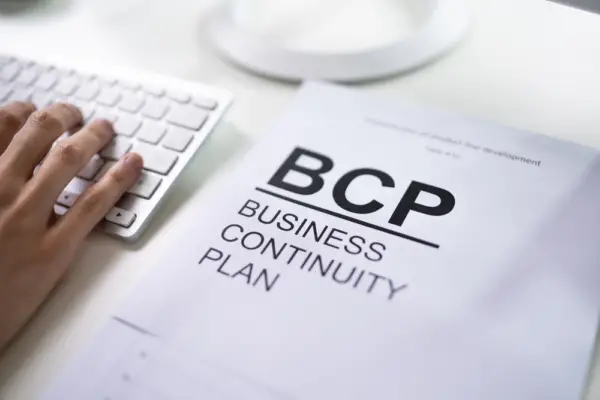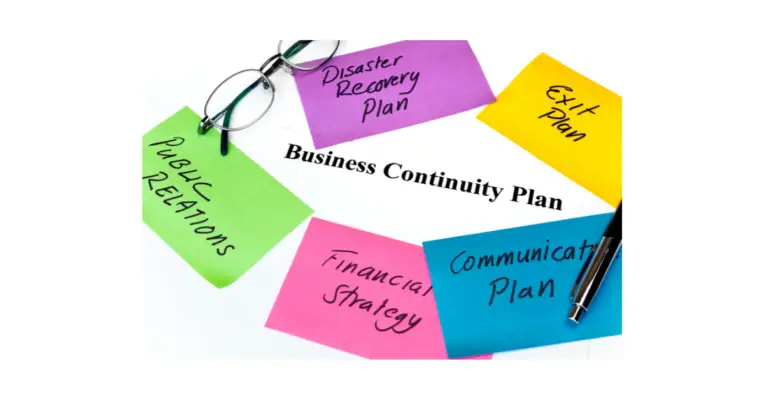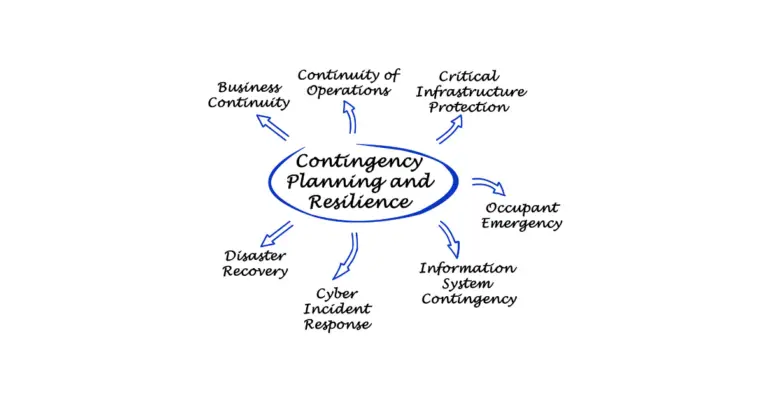Business Continuity Planning (BCP) is a proactive approach to ensure that a business can continue its critical operations during and after a crisis.
A Business Continuity Plan Template serves as a blueprint for businesses to follow when faced with a crisis. It outlines the steps and procedures a company will take to ensure it can continue operating during and after a crisis.
A Business Continuity Plan Template includes information about key people, assets, and partners, human resource functions, and other helpful information that can help maintain a company’s relationships with relevant stakeholders.
It is a practical guide developed by companies to enable continuous operations in the event of major business disruptions like natural disasters, cyber-attacks, or global lockdowns.

A well-designed Business Continuity Plan Template can help businesses minimize the impact of a crisis and ensure that they can resume their operations as quickly as possible.
It can also help companies to maintain their reputation and relationships with customers, suppliers, and other stakeholders. With the right BCP Template, businesses can be better prepared to handle any crisis that comes their way.
Key Takeaways
- A Business Continuity Plan Template serves as a blueprint for businesses to follow when faced with a crisis.
- It includes information about key people, assets, and partners, human resource functions, and other helpful information.
- A well-designed Business Continuity Plan Template can help businesses minimize the impact of a crisis and ensure that they can resume their operations as quickly as possible.
Understanding Business Continuity Planning
Definition and Purpose
A Business Continuity Plan (BCP) is a document that outlines how an organization will continue to operate during a business disruption.
It is a preventative measure designed to minimize the impact of a disruption on an organization’s personnel and assets.
A BCP is a comprehensive plan that includes procedures, protocols, and guidelines to ensure that essential business functions can continue during and after a disruption.
The purpose of a BCP is to ensure that an organization can continue to operate during a crisis. The plan is designed to help an organization recover quickly and efficiently from a disruption, minimizing the impact on the organization’s operations, employees, and customers.
A BCP is a critical component of an organization’s risk management strategy.
Importance of BCP in Risk Management
A BCP is an essential part of an organization’s risk management strategy. It is designed to minimize the impact of a business disruption on an organization’s operations, employees, and customers.
By having a BCP in place, an organization can minimize the risks associated with a business disruption, including financial loss, damage to reputation, and loss of customers.
A BCP is an important tool for managing risk because it helps an organization identify potential risks and develop strategies to mitigate them.
By identifying potential risks and developing strategies to mitigate those risks, an organization can minimize the likelihood of a disruption occurring in the first place.
A BCP is critical to an organization’s risk management strategy. It is designed to ensure that an organization can continue to operate during a crisis, minimizing the impact on the organization’s operations, employees, and customers.
By having a BCP in place, an organization can minimize the risks associated with a business disruption, including financial loss, damage to reputation, and loss of customers.
Key Components of a BCP Template
A Business Continuity Plan (BCP) template is a document that outlines procedures and instructions an organization must follow in the event of a crisis or disaster. A well-designed BCP template should include the following key components:
Scope and Objectives
The scope and objectives section of a BCP template outlines the purpose of the plan and the scope of the plan. It defines the plan’s boundaries, including the departments, functions, and processes covered by the plan.
It also outlines the plan’s objectives, which should be specific, measurable, achievable, relevant, and time-bound.
Roles and Responsibilities
The roles and responsibilities section of a BCP template outlines the individuals or teams responsible for executing the plan.
It should clearly define the roles and responsibilities of each team member, including their specific tasks and the timelines for completing those tasks.
We will also include contact information for key personnel, such as emergency response teams and external vendors.
Key Business Areas
A BCP template’s key business areas section identifies the critical business areas that must be protected during a crisis or disaster.
We should include a list of the business areas essential to the organization’s operations, such as finance, information technology, and human resources.
It should also outline the steps that must be taken to protect these areas, such as backup and recovery procedures.

Critical Functions
The critical functions section of a BCP template identifies the specific functions or processes essential to the organization’s operations.
We should include a list of the critical functions and processes that must be protected during a crisis or disaster, such as payroll processing or order fulfilment.
It should also outline the steps that must be taken to protect these functions, such as alternate processing procedures or manual workarounds.
A well-designed BCP template should include the scope and objectives, roles and responsibilities, key business areas, and critical functions.
These components are essential for ensuring an organization can respond effectively to a crisis or disaster and minimize its impact on its operations.
Risk Assessment and Business Impact Analysis
Identifying Potential Risks
Before creating a business continuity plan template, it’s important to identify potential risks that could disrupt business operations. These risks can be categorized into different types, such as natural disasters, cyber-attacks, power outages, and supply chain disruptions.
According to a Business Impact Analysis (BIA) conducted by Asana, “the most common types of business disruptions are power outages, cyber-attacks, and natural disasters.”
Therefore, it’s important to consider these risks when identifying potential threats to business operations.
To identify potential risks, businesses can conduct a risk assessment. This involves reviewing the different areas of the business and identifying potential threats.
For example, a risk assessment could involve reviewing the physical location of the business and identifying potential natural disasters that could occur in the area.
Analyzing Business Impact
Once potential risks have been identified, it’s important to analyze their potential impact on business operations. This is where a Business Impact Analysis (BIA) comes into play.
A BIA is a process of predicting the organizational and financial impact of business disruptions. It collects relevant data to aid businesses in creating the fastest recovery strategies to get companies back to normal after inevitable consequences.
A BIA can help businesses understand the potential impact of a disruption on different business areas, such as revenue, customer service, and employee productivity.
Businesses can prioritize which risks to address in their business continuity plan template by analysing the potential impact of different risks.
For example, if a cyber-attack could significantly impact revenue, then it may be a higher priority than a power outage that only affects employee productivity.
Identifying potential risks and analyzing their impact is crucial in creating a comprehensive business continuity plan template.
Developing Recovery Strategies
A key component of a business continuity plan is developing recovery strategies and plans that outline how a business will restore its operations, resources, and capabilities after an incident.
Recovery strategies are developed based on the impact analysis and risk assessment conducted during the business continuity planning.
The strategies should be designed to minimize the impact of disruptions on the business and ensure that critical business functions can be restored within an acceptable timeframe.
Designing Recovery Plans
The recovery plan should include clear and concise procedures for restoring critical business functions, such as IT systems, communication systems, and other essential services.
The plan should also identify the recovery objectives and the resources required to achieve them. Recovery objectives should be specific, measurable, achievable, relevant, and time-bound (SMART).
It should be tested and updated regularly to ensure the recovery plan is effective. Testing can help identify gaps and areas for improvement in the recovery plan, while regular updates can ensure that the plan remains relevant and up-to-date.
Establishing a Recovery Team
Establishing a recovery team is essential to the success of the recovery plan. The recovery team should be composed of individuals with the necessary skills and expertise to restore critical business functions.
The team should also have clear roles and responsibilities, and communication channels should be established to ensure team members can work effectively together.
The recovery team should be trained on the recovery plan and procedures, and regular drills and exercises should be conducted to ensure that the team is prepared to respond to an incident.
The recovery team should also have access to the necessary resources, such as equipment, software, and other tools, to enable them to carry out their roles effectively.
In summary, developing recovery strategies is critical to a business continuity plan. Recovery plans should minimise disruptions‘ impact on the business and ensure that critical business functions can be restored within an acceptable timeframe.
Establishing a recovery team is also essential to the success of the recovery plan, and the team should be trained and equipped to carry out their roles effectively.
Plan Implementation and Training
Implementing a business continuity plan (BCP) requires a comprehensive approach that includes training and testing.
The plan should be regularly reviewed, updated, and tested to ensure it remains effective and relevant to the organization’s needs.
Communication Plan
A key component of BCP implementation is communication. A communication plan should be developed to ensure that all stakeholders are informed of the plan’s activation and the steps that will be taken to ensure business continuity.
The communication plan should include contact information for all key personnel, vendors, suppliers, and any external agencies involved in the response effort.
Training Programs and Exercises
Training programs and exercises are critical components of BCP implementation. Employees should be trained on their roles and responsibilities during a disruption and familiar with the plan’s procedures.
Regular exercises should be conducted to test the plan’s effectiveness and identify areas for improvement.
Training programs should be tailored to the organisation’s specific needs and include both general awareness training and specialized training for key personnel.
Exercises should be designed to simulate various scenarios, including natural disasters, cyber-attacks, and other disruptions.
Effective BCP implementation requires a comprehensive approach that includes regular review, testing, and training.
By taking a proactive approach to business continuity planning, organizations can minimize the impact of disruptions and ensure that they are able to continue operations in the face of adversity.
Maintaining and Testing the BCP
A Business Continuity Plan (BCP) is a living document, which means it needs to be updated regularly to ensure its relevance and effectiveness.
We will discuss the importance of maintaining and testing the BCP to ensure it is up-to-date and functional.

Scheduled Review and Updates
To maintain the BCP, it is essential to conduct regular reviews and updates. The frequency of the reviews depends on the organization’s size, complexity, and risk profile.
Typically, the BCP should be reviewed at least annually, but it is recommended to review it every six months or quarterly.
During the review, the BCP team should evaluate the plan’s effectiveness and identify any gaps or deficiencies. They should also ensure the plan aligns with the organization’s business objectives, processes, and technology infrastructure.
The review should result in updates to the BCP, including any changes to the recovery procedures, contact lists, and other critical information.
Testing and Exercise Protocols
Testing is a critical component of maintaining the BCP. Testing allows the organization to identify any gaps or deficiencies in the plan and ensure the recovery procedures are functional.
The BCP team should develop a testing and exercise protocol that outlines the testing objectives, scope, and methodology.
The testing and exercise protocol should include the following:
- Plan testing: The BCP team should test the plan’s recovery procedures to ensure they are functional and effective. The testing should include a full-scale test of the plan, including the activation of the emergency operations centre and the recovery of critical business functions.
- Tabletop exercises: The BCP team should conduct tabletop exercises to test the plan’s effectiveness in a simulated environment. Tabletop exercises are an excellent way to identify gaps or deficiencies in the plan and ensure the recovery procedures are functional.
- Communication testing: The BCP team should test the communication protocols to ensure the contact lists are accurate and up-to-date. The testing should include a test of the emergency notification system to ensure it is functional.
Maintaining and testing the BCP is critical to ensuring that the organization can recover from a disruptive event. Regular reviews and updates, along with testing and exercise protocols, can help the organization identify any gaps or deficiencies in the plan and ensure that the recovery procedures are functional.
BCP in Action: Response and Recovery
Emergency Response and Operations
When a disaster strikes, the first priority is to ensure the safety of employees and customers. A business continuity plan template should include an emergency response plan that outlines the steps to take in case of a crisis.
This plan should identify the emergency response team, their roles and responsibilities, and the communication channels to be used during an emergency.
The plan should also include evacuation procedures, emergency contacts, and instructions for shutting down critical systems and equipment.
Business Continuity and Recovery Phases
Once the emergency response phase is over, the focus shifts to business continuity and recovery. A business continuity plan template should outline the steps to take to ensure that critical business functions can continue during and after a crisis.
This plan should include a list of critical business processes and systems, and the steps to take to restore them in case of an outage.
It should also include a communication plan to keep employees, customers, and other stakeholders informed about the recovery status.
The business continuity and recovery phases can be broken down into several stages, including:
- Damage Assessment: This involves assessing the extent of the damage caused by the disaster and identifying the resources needed to restore critical systems and processes.
- Recovery Strategy: This involves developing a recovery strategy outlining the steps to restore critical systems and processes. This strategy should include a timeline, resource requirements, and a communication plan.
- Recovery Plan Implementation involves implementing the recovery plan and restoring critical systems and processes. This may involve repairing or replacing damaged equipment, restoring backup data, and testing systems to ensure they function properly.
- Business Continuity: This involves ensuring critical business functions can continue during and after recovery. This may involve implementing workarounds or alternative processes to ensure critical functions can continue even if some systems or processes are offline.
A business continuity plan template should provide a comprehensive framework for responding to a crisis and ensuring that critical business functions can continue during and after the crisis.
By following this framework, businesses can minimize the impact of a crisis on their operations and ensure that they can quickly recover and resume normal operations.
Tools and Resources for BCP
Business continuity planning is a crucial process that requires careful consideration and preparation. Fortunately, there are many tools and resources available to help organizations create effective BCPs. Here are some of the most useful resources for BCP:

Technology and Platforms
Technology plays a significant role in BCP, and there are many platforms available that can help organizations create and manage their plans. These platforms range from simple templates to complex software solutions that offer advanced features such as risk assessment, incident management, and automated notifications.
Some of the most popular BCP platforms include:
- Datto – a cloud-based platform offering a wide range of tools for disaster recovery and business continuity planning tools.
- BMC Helix – a comprehensive IT service management platform that includes BCP functionality.
- Onspring – a flexible platform that allows organizations to create customized BCPs and manage the entire planning process.
BCP Templates and Examples
One of the best ways to get started with BCP is to use a template or example plan as a starting point. These resources provide a framework for creating a BCP and can help organizations identify critical business processes, assess risks, and develop recovery strategies.
There are many BCP templates and examples available online, including:
- HubSpot – offers a comprehensive BCP template that includes sections on operational continuity, communication, and recovery strategies.
- BDC – provides an eight-step guide to creating a BCP, along with templates for assessing critical services and developing recovery strategies.
- Smartsheet – offers a customizable BCP template that includes sections on purpose and scope, business impact analysis, and recovery strategies.
Using a template or example plan can help organizations save time and ensure that their BCP covers all the necessary elements.
However, it’s important to remember that every organization’s needs are different, and templates should be customized to reflect the unique risks and requirements of each organization.
In conclusion, there are many tools and resources available to help organizations create effective BCPs. By leveraging the right technology and using templates and examples as a starting point, organizations can develop comprehensive plans that will help them weather any disruption or disaster.
Download the Business continuity management template.

Chris Ekai is a Risk Management expert with over 10 years of experience in the field. He has a Master’s(MSc) degree in Risk Management from University of Portsmouth and is a CPA and Finance professional. He currently works as a Content Manager at Risk Publishing, writing about Enterprise Risk Management, Business Continuity Management and Project Management.

